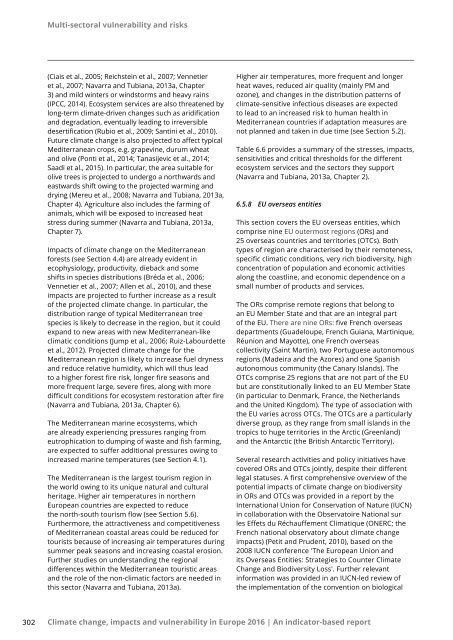Climate change impacts and vulnerability in Europe 2016
document
document
Create successful ePaper yourself
Turn your PDF publications into a flip-book with our unique Google optimized e-Paper software.
Multi-sectoral <strong>vulnerability</strong> <strong>and</strong> risks<br />
(Ciais et al., 2005; Reichste<strong>in</strong> et al., 2007; Vennetier<br />
et al., 2007; Navarra <strong>and</strong> Tubiana, 2013a, Chapter<br />
3) <strong>and</strong> mild w<strong>in</strong>ters or w<strong>in</strong>dstorms <strong>and</strong> heavy ra<strong>in</strong>s<br />
(IPCC, 2014). Ecosystem services are also threatened by<br />
long‐term climate‐driven <strong>change</strong>s such as aridification<br />
<strong>and</strong> degradation, eventually lead<strong>in</strong>g to irreversible<br />
desertification (Rubio et al., 2009; Sant<strong>in</strong>i et al., 2010).<br />
Future climate <strong>change</strong> is also projected to affect typical<br />
Mediterranean crops, e.g. grapev<strong>in</strong>e, durum wheat<br />
<strong>and</strong> olive (Ponti et al., 2014; Tanasijevic et al., 2014;<br />
Saadi et al., 2015). In particular, the area suitable for<br />
olive trees is projected to undergo a northwards <strong>and</strong><br />
eastwards shift ow<strong>in</strong>g to the projected warm<strong>in</strong>g <strong>and</strong><br />
dry<strong>in</strong>g (Mereu et al., 2008; Navarra <strong>and</strong> Tubiana, 2013a,<br />
Chapter 4). Agriculture also <strong>in</strong>cludes the farm<strong>in</strong>g of<br />
animals, which will be exposed to <strong>in</strong>creased heat<br />
stress dur<strong>in</strong>g summer (Navarra <strong>and</strong> Tubiana, 2013a,<br />
Chapter 7).<br />
Impacts of climate <strong>change</strong> on the Mediterranean<br />
forests (see Section 4.4) are already evident <strong>in</strong><br />
ecophysiology, productivity, dieback <strong>and</strong> some<br />
shifts <strong>in</strong> species distributions (Bréda et al., 2006;<br />
Vennetier et al., 2007; Allen et al., 2010), <strong>and</strong> these<br />
<strong>impacts</strong> are projected to further <strong>in</strong>crease as a result<br />
of the projected climate <strong>change</strong>. In particular, the<br />
distribution range of typical Mediterranean tree<br />
species is likely to decrease <strong>in</strong> the region, but it could<br />
exp<strong>and</strong> to new areas with new Mediterranean‐like<br />
climatic conditions (Jump et al., 2006; Ruiz‐Labourdette<br />
et al., 2012). Projected climate <strong>change</strong> for the<br />
Mediterranean region is likely to <strong>in</strong>crease fuel dryness<br />
<strong>and</strong> reduce relative humidity, which will thus lead<br />
to a higher forest fire risk, longer fire seasons <strong>and</strong><br />
more frequent large, severe fires, along with more<br />
difficult conditions for ecosystem restoration after fire<br />
(Navarra <strong>and</strong> Tubiana, 2013a, Chapter 6).<br />
The Mediterranean mar<strong>in</strong>e ecosystems, which<br />
are already experienc<strong>in</strong>g pressures rang<strong>in</strong>g from<br />
eutrophication to dump<strong>in</strong>g of waste <strong>and</strong> fish farm<strong>in</strong>g,<br />
are expected to suffer additional pressures ow<strong>in</strong>g to<br />
<strong>in</strong>creased mar<strong>in</strong>e temperatures (see Section 4.1).<br />
The Mediterranean is the largest tourism region <strong>in</strong><br />
the world ow<strong>in</strong>g to its unique natural <strong>and</strong> cultural<br />
heritage. Higher air temperatures <strong>in</strong> northern<br />
<strong>Europe</strong>an countries are expected to reduce<br />
the north‐south tourism flow (see Section 5.6).<br />
Furthermore, the attractiveness <strong>and</strong> competitiveness<br />
of Mediterranean coastal areas could be reduced for<br />
tourists because of <strong>in</strong>creas<strong>in</strong>g air temperatures dur<strong>in</strong>g<br />
summer peak seasons <strong>and</strong> <strong>in</strong>creas<strong>in</strong>g coastal erosion.<br />
Further studies on underst<strong>and</strong><strong>in</strong>g the regional<br />
differences with<strong>in</strong> the Mediterranean touristic areas<br />
<strong>and</strong> the role of the non-climatic factors are needed <strong>in</strong><br />
this sector (Navarra <strong>and</strong> Tubiana, 2013a).<br />
Higher air temperatures, more frequent <strong>and</strong> longer<br />
heat waves, reduced air quality (ma<strong>in</strong>ly PM <strong>and</strong><br />
ozone), <strong>and</strong> <strong>change</strong>s <strong>in</strong> the distribution patterns of<br />
climate-sensitive <strong>in</strong>fectious diseases are expected<br />
to lead to an <strong>in</strong>creased risk to human health <strong>in</strong><br />
Mediterranean countries if adaptation measures are<br />
not planned <strong>and</strong> taken <strong>in</strong> due time (see Section 5.2).<br />
Table 6.6 provides a summary of the stresses, <strong>impacts</strong>,<br />
sensitivities <strong>and</strong> critical thresholds for the different<br />
ecosystem services <strong>and</strong> the sectors they support<br />
(Navarra <strong>and</strong> Tubiana, 2013a, Chapter 2).<br />
6.5.8 EU overseas entities<br />
This section covers the EU overseas entities, which<br />
comprise n<strong>in</strong>e EU outermost regions (ORs) <strong>and</strong><br />
25 overseas countries <strong>and</strong> territories (OTCs). Both<br />
types of region are characterised by their remoteness,<br />
specific climatic conditions, very rich biodiversity, high<br />
concentration of population <strong>and</strong> economic activities<br />
along the coastl<strong>in</strong>e, <strong>and</strong> economic dependence on a<br />
small number of products <strong>and</strong> services.<br />
The ORs comprise remote regions that belong to<br />
an EU Member State <strong>and</strong> that are an <strong>in</strong>tegral part<br />
of the EU. There are n<strong>in</strong>e ORs: five French overseas<br />
departments (Guadeloupe, French Guiana, Mart<strong>in</strong>ique,<br />
Réunion <strong>and</strong> Mayotte), one French overseas<br />
collectivity (Sa<strong>in</strong>t Mart<strong>in</strong>), two Portuguese autonomous<br />
regions (Madeira <strong>and</strong> the Azores) <strong>and</strong> one Spanish<br />
autonomous community (the Canary Isl<strong>and</strong>s). The<br />
OTCs comprise 25 regions that are not part of the EU<br />
but are constitutionally l<strong>in</strong>ked to an EU Member State<br />
(<strong>in</strong> particular to Denmark, France, the Netherl<strong>and</strong>s<br />
<strong>and</strong> the United K<strong>in</strong>gdom). The type of association with<br />
the EU varies across OTCs. The OTCs are a particularly<br />
diverse group, as they range from small isl<strong>and</strong>s <strong>in</strong> the<br />
tropics to huge territories <strong>in</strong> the Arctic (Greenl<strong>and</strong>)<br />
<strong>and</strong> the Antarctic (the British Antarctic Territory).<br />
Several research activities <strong>and</strong> policy <strong>in</strong>itiatives have<br />
covered ORs <strong>and</strong> OTCs jo<strong>in</strong>tly, despite their different<br />
legal statuses. A first comprehensive overview of the<br />
potential <strong>impacts</strong> of climate <strong>change</strong> on biodiversity<br />
<strong>in</strong> ORs <strong>and</strong> OTCs was provided <strong>in</strong> a report by the<br />
International Union for Conservation of Nature (IUCN)<br />
<strong>in</strong> collaboration with the Observatoire National sur<br />
les Effets du Réchauffement Climatique (ONERC; the<br />
French national observatory about climate <strong>change</strong><br />
<strong>impacts</strong>) (Petit <strong>and</strong> Prudent, 2010), based on the<br />
2008 IUCN conference 'The <strong>Europe</strong>an Union <strong>and</strong><br />
its Overseas Entities: Strategies to Counter <strong>Climate</strong><br />
Change <strong>and</strong> Biodiversity Loss'. Further relevant<br />
<strong>in</strong>formation was provided <strong>in</strong> an IUCN-led review of<br />
the implementation of the convention on biological<br />
302 <strong>Climate</strong> <strong>change</strong>, <strong>impacts</strong> <strong>and</strong> <strong>vulnerability</strong> <strong>in</strong> <strong>Europe</strong> <strong>2016</strong> | An <strong>in</strong>dicator-based report


